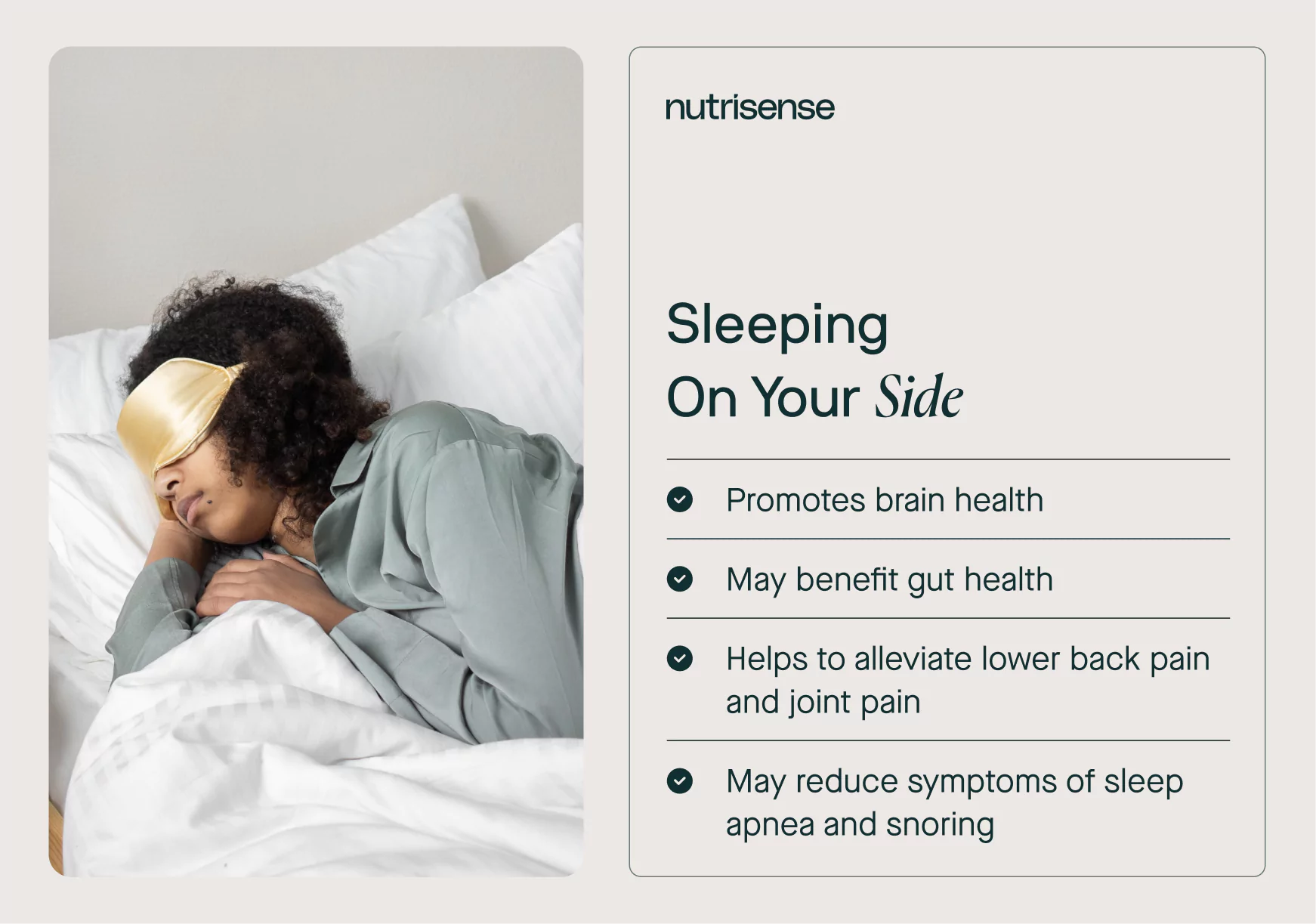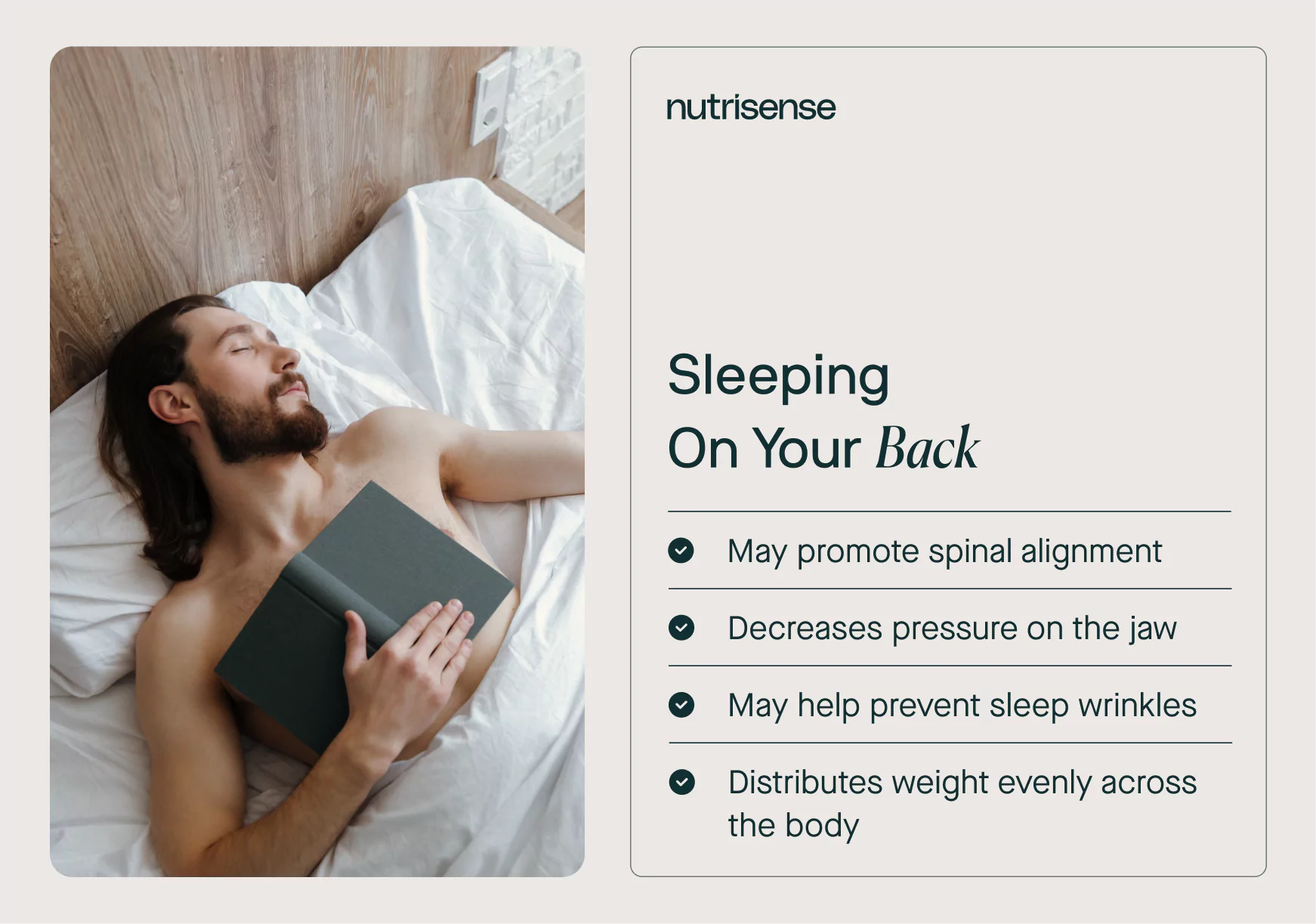Sleep Tight: The Top 3 Sleeping Positions for a Better Night's Rest

Key Takeways
Did you know that one in three adults worldwide have symptoms of insomnia? That’s right—and 10 percent of the population meets the clinical criteria for insomnia disorder.
Insomnia is only one of several sleep disorders, with stress being a major root cause of poor sleep. A lot of different factors, such as your diet and activity levels can affect your sleep.
If you’re someone who has struggled with sleep, you may have invested in the best mattresses, sleep apps, and even tried sleep medicine to help you get some shut eye. Whether or not you have trouble sleeping, you might be wondering if you could be improving your quality sleep by sleeping in another position.
So, can different sleeping positions affect things like sleep quality, spine alignment, and even blood pressure? Let’s explore the benefits of each position.
1) Sleeping on Your Side

With the proper pillow, lateral sleeping (or opting for a side sleeping position) promotes spinal alignment — one of the most important concepts to keep in mind when choosing a sleeping position.
Health Benefits of Side Sleeping
- Helps to alleviate lower back pain and joint pain
- May reduce symptoms of sleep apnea and snoring
- Promotes brain health by increasing the efficiency with which the glymphatic system, your brain’s detoxification system
- May benefit gut health by putting less pressure on your digestive system
Cons of Sleeping on Your Side

- May cause shoulder pain on the side you sleep on
- May similarly cause jaw discomfort from putting pressure on one side of the body
- Sleeping in the fetal position, with your knees pulled toward your chest, promotes an uneven distribution of weight that can cause back and joint pain
When to Consider Sleeping on Your Side
You might consider giving sleeping on your side a go if you have low back pain or sleep apnea. If you have acid reflux, take care to sleep on your left side to decrease symptoms.
To optimize spinal alignment, choose a pillow with a loft that matches the distance between your shoulder and neck, and try placing a thin pillow between your knees to prevent stress on your top hip and lower back.
2) Sleeping on Your Back

If you’ve ever laid in savasana at the end of a yoga class, and the teacher offered you a bolster to put under your knees, it was to support the natural curvature of the spine, which is said to be a benefit of supine, or back sleeping.
Health Benefits of Back Sleeping
- Distributes weight evenly across the body and may promote spinal alignment
- Decreases pressure on the jaw
- Helps to prevent sleep wrinkles (facial wrinkles from sleep)
Cons of Sleeping on Your Back

- May worsen nasal congestion, exacerbating allergies, leading to post-nasal drip, and causing you to breathe through your mouth
- May worsen snoring, which can also be improved by using a pillow
- May increase pressure in your lungs and restrict your airway, worsening obstructive sleep apnea
When to Consider Sleeping on Your Back
While not as popular a sleeping position as side sleeping, back sleeping can be a good option for people who would like to experiment with supporting the spine by placing pillows under the knees and low back.
If you’re concerned about your skin health, back sleeping—and techniques to maximize beauty sleep— this position may help to minimize the appearance of aging.
3) Sleeping on Your Stomach

Prone sleeping (sleeping on your stomach) isn’t a popular primary sleeping position, and it has more limited benefits. That said, there may be a few health benefits for stomach sleepers.
Health Benefits of Stomach Sleeping
- Can help to alleviate obstructive sleep apnea as compared to the supine sleeping position
- Can be a good choice for people who snore
- When not a primary sleeping position, can relieve pressure on other parts of the body for brief moments throughout the night
Cons of Sleeping on Your Stomach
- Strains the neck and puts pressure on your jaw from turning your face to one side
- Isn’t supportive and makes it impossible to maintain a neutral spine
- Can lead to numbness in the hands and arms if you put your arms under your pillow
- Compresses the skin the most of any sleeping position, which may increase the likelihood of developing facial wrinkles
When to Consider Sleeping on Your Stomach

When it comes to the best sleeping position, sleeping on your stomach isn’t generally recommended. If sleeping on your stomach is how you sleep comfortably, though, and you’re waking up feeling rested, don’t feel a need to change your sleeping position.
Things to Consider When Choosing a Sleeping Position
Historically, back sleeping has been regarded as the “healthiest” sleeping position. However, health professionals are increasingly becoming mixed as to whether a supine or lateral position is best.
This is because sleeping positions are personal—what’s right for you depends on whether you have any health conditions and what you find comfortable. After all, the goal of any sleeping position is to ensure a good night’s sleep.
If you are experiencing pain or have an underlying health condition, however, keep reading and talk to your doctor to make an informed decision about whether to train yourself to sleep in a new position.
Pain in the Back or Neck

When choosing a sleeping position, it is essential to take any current back or neck pain you may be experiencing into consideration. Even though back sleeping helps to maintain neutrality along your spine, some people may find that it aggravates existing pain.
While sleep posture can help to reduce pain levels, make sure to talk to your doctor about what’s causing your pain and how a new sleeping posture could affect you. Depending on the cause of the pain, one position over another may be more helpful.
For example, research suggests that if you have mid-back pain, side sleeping can be beneficial, while if you have low back pain, back sleeping may be better.
Obstructive Sleep Apnea or Snoring
Two kinds of sleep apnea exist: obstructive sleep apnea (OSA) and central sleep apnea. The first is more common and happens when air can’t flow properly through the nose or mouth, although your body is trying to breathe.
A polysomnography (formal sleep study) can help you to determine whether you have OSA. It can also identify whether you have positional obstructive sleep apnea, which can be alleviated by changing the positioning of your body and head when you sleep in what is known as positional therapy.
Sleeping on your back can both aggravate snoring and lead to more frequent episodes of sleep apnea by making it more likely that your airway will narrow or become blocked. If you have sleep apnea, have symptoms of sleep apnea, or are at risk of developing sleep apnea, consider sleeping on your side or stomach.
Acid Reflux and Heartburn

Acid reflux, heartburn, and gastroesophageal reflux disease (GERD) are terms often used interchangeably. GERD is a more severe form of acid reflux that can be caused by repeated episodes of mild acid reflux over time.
Left side sleeping is recommended for acid reflux and related conditions because it takes pressure off of your stomach. Opt for the left side, not the right, as research shows that left side sleeping can improve symptoms while right side sleeping worsens them.
Back sleeping has also been shown to be safe for people with acid reflux. Elevating your esophagus and shoulder blades above your stomach may help to minimize symptoms during the night.
A Note on Sleeping Positions for Pregnant Women

Healthcare providers recommend sleeping on your side throughout pregnancy, most of all during late pregnancy. Sleeping on the left side in particular may improve blood flow to and from the heart, fetus, uterus, and kidneys while keeping pressure off of your liver.
Not only is this sleeping position thought to be healthiest for the baby, but sleeping on your side with knees bent will likely be the most comfortable position for you, too. If sleeping on your left side becomes uncomfortable, it’s okay to switch to the right side from time to time.
If you have concerns associated with pregnancy symptoms or aren’t certain how to best support your baby while sleeping, make sure to talk to your doctor.
Find the right Nutrisense programto turn insight into progress.
Go Beyond Glucose Data with Nutrisense
Your glucose can significantly impact how your body feels and functions. That’s why stable levels are an important factor in supporting overall wellbeing. But viewing glucose isn't enough. Nutrisense, you’ll be able to learn how to use your body's data to make informed lifestyle choices that support healthy living.
One-to-one coaching
Sign up to access insurance-covered video calls to work with a glucose expert: a personal registered dietitian or certified nutritionist who will help tailor your lifestyle and diet to your goals.
Monitor and measure what matters
With the Nutrisense CGM Program, you can monitor your glucose with health tech like glucose biosensors and continuous glucose monitor (CGM)s, and analyze the trends over time with the Nutrisense App. This will help you make the most informed choices about the foods you consume and their impact on your health.
Find your best fit
Ready to take the first step? Start with our quiz to find the right Nutrisense program to help you take control.

Heather is a Registered and Licensed Dietitian Nutritionist (RDN, LDN), subject matter expert, and technical writer, with a master's degree in nutrition science from Bastyr University. She has a specialty in neuroendocrinology and has been working in the field of nutrition—including nutrition research, education, medical writing, and clinical integrative and functional nutrition—for over 15 years.




